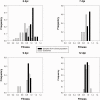Genetic variation in fitness within a clonal population of a plant RNA virus
- PMID: 27774299
- PMCID: PMC4989883
- DOI: 10.1093/ve/vew006
Genetic variation in fitness within a clonal population of a plant RNA virus
Abstract
A long-standing observation in evolutionary virology is that RNA virus populations are highly polymorphic, composed by a mixture of genotypes whose abundances in the population depend on complex interaction between fitness differences, mutational coupling and genetic drift. It was shown long ago, though in cell cultures, that most of these genotypes had lower fitness than the population they belong, an observation that explained why single-virion passages turned on Muller's ratchet while very large population passages resulted in fitness increases in novel environments. Here we report the results of an experiment specifically designed to evaluate in vivo the fitness differences among the subclonal components of a clonal population of the plant RNA virus tobacco etch potyvirus (TEV). Over 100 individual biological subclones from a TEV clonal population well adapted to the natural tobacco host were obtained by infectivity assays on a local lesion host. The replicative fitness of these subclones was then evaluated during infection of tobacco relative to the fitness of large random samples taken from the starting clonal population. Fitness was evaluated at increasing number of days post-inoculation. We found that at early days, the average fitness of subclones was significantly lower than the fitness of the clonal population, thus confirming previous observations that most subclones contained deleterious mutations. However, as the number of days of viral replication increases, population size expands exponentially, more beneficial and compensatory mutations are produced, and selection becomes more effective in optimizing fitness, the differences between subclones and the population disappeared.
Keywords: experimental evolution; fitness; genetic diversity; mutant swarm; potyvirus; virus evolution.
Figures


Similar articles
-
Subclonal components of consensus fitness in an RNA virus clone.J Virol. 1994 Jul;68(7):4295-301. doi: 10.1128/JVI.68.7.4295-4301.1994. J Virol. 1994. PMID: 8207804 Free PMC article.
-
Fitness declines in Tobacco etch virus upon serial bottleneck transfers.J Virol. 2007 May;81(10):4941-7. doi: 10.1128/JVI.02528-06. Epub 2007 Mar 7. J Virol. 2007. PMID: 17344305 Free PMC article.
-
Fitness of RNA virus decreased by Muller's ratchet.Nature. 1990 Nov 29;348(6300):454-5. doi: 10.1038/348454a0. Nature. 1990. PMID: 2247152
-
Rapid fitness losses in mammalian RNA virus clones due to Muller's ratchet.Proc Natl Acad Sci U S A. 1992 Jul 1;89(13):6015-9. doi: 10.1073/pnas.89.13.6015. Proc Natl Acad Sci U S A. 1992. PMID: 1321432 Free PMC article.
-
Evolution of sex and the molecular clock in RNA viruses.Gene. 1997 Dec 31;205(1-2):301-8. doi: 10.1016/s0378-1119(97)00405-8. Gene. 1997. PMID: 9461404 Review.
Cited by
-
Tradeoffs for a viral mutant with enhanced replication speed.Proc Natl Acad Sci U S A. 2021 Jul 27;118(30):e2105288118. doi: 10.1073/pnas.2105288118. Proc Natl Acad Sci U S A. 2021. PMID: 34282021 Free PMC article.
-
A Two-Level, Intramutant Spectrum Haplotype Profile of Hepatitis C Virus Revealed by Self-Organized Maps.Microbiol Spectr. 2021 Dec 22;9(3):e0145921. doi: 10.1128/Spectrum.01459-21. Epub 2021 Nov 10. Microbiol Spectr. 2021. PMID: 34756074 Free PMC article.
-
Intra-Population Competition during Adaptation to Increased Temperature in an RNA Bacteriophage.Int J Mol Sci. 2021 Jun 24;22(13):6815. doi: 10.3390/ijms22136815. Int J Mol Sci. 2021. PMID: 34202838 Free PMC article.
-
Differences in adaptive dynamics determine the success of virus variants that propagate together.Virus Evol. 2018 Jan 9;4(1):vex043. doi: 10.1093/ve/vex043. eCollection 2018 Jan. Virus Evol. 2018. PMID: 29340211 Free PMC article.
References
-
- Agudelo-Romero P., De la Iglesia F., Elena S. F. (2008) ‘The Pleiotropic Cost of Host-Specialization in Tobacco Etch Potyvirus’, Infection Genetics and Evolution, 8: 806–14. - PubMed
-
- Ali A., Roossinck M. J. (2010) ‘Genetic Bottlenecks During Systemic Movement of Cucumber mosaic virus Vary in Different Host Plants’, Virology, 404: 279–83. - PubMed
-
- Bedhomme S., Lafforgue G., Elena S. F. (2012) ‘Multihost Experimental Evolution of a Plant RNA Virus Reveals Local Adaptation and Host-Specific Mutations’, Molecular Biology and Evolution, 29: 1481–92. - PubMed
-
- Bedoya L. C., Daròs J. A. (2010) ‘Stability of Tobacco etch virus Infectious Clones in Plasmid Vectors’, Virus Research, 149: 234–40. - PubMed
LinkOut - more resources
Full Text Sources
Other Literature Sources
Molecular Biology Databases

